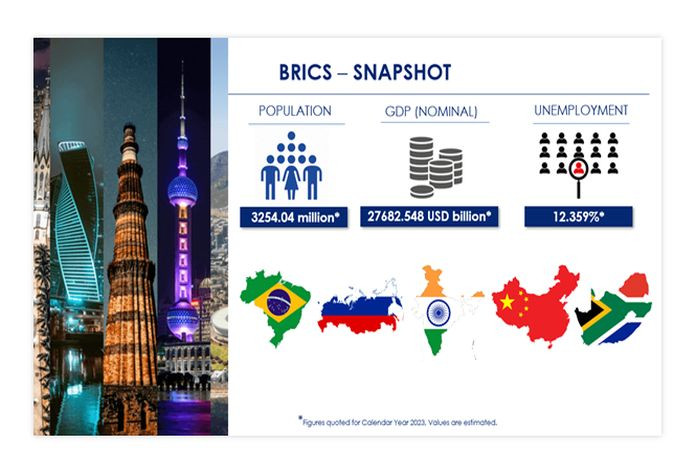– The “BRICS Snapshot – PESTLE, SWOT, Risk and Macroeconomic Trends Analysis” country profile has been added to ResearchAndMarkets.com’s offering.
DUBLIN, Ireland – BRICS Snapshot – PESTLE, SWOT, Risk and Macroeconomic Analysis report is designed to provide in-depth information about BRICS (Brazil, Russia, India, China, and South Africa) countries including their PESTLE (political, economic, social, technological, legal and environmental), SWOT (Strengths, Weaknesses, Opportunities and Threats) and country risk analysis backed by macroeconomic data.
BRICS is an informal group of states comprising the Federative Republic of Brazil, the Russian Federation, the Republic of India, the People’s Republic of China and the Republic of South Africa. It was formed on June 16, 2009 as BRIC comprising of Brazil, Russia, India and China as founding members. South Africa joined BRICS in December 2010.
BRICS countries are influential members of leading international organizations and agencies, including the UN, the G20, the Non-Aligned Movement and the Group of 77. They are also members of various regional associations. The Russian Federation is a member of the Commonwealth of Independent States (CIS), the Collective Security Treaty Organisation (CSTO) and the Eurasian Economic Union (EEU).
Russia and China are members of the Shanghai Cooperation Organisation (SCO) and the Asia Pacific Economic Cooperation (APEC). Brazil is a member of the Union of South American Nations, MERCOSUR and the Community of Latin American and Caribbean States. The Republic of South Africa is a member of the African Union and the Southern African Development Community. India is a member of the South Asian Association for Regional Cooperation (SAARC).
BRICS (Brazil, Russia, India, China, South Africa) countries are estimated to have a population of 3.267 billion in the year 2023 and are expected to reach 3.305 billion by 2027, increasing at a CAGR of 0.29 percent.
BRICS’s nominal gross domestic product (GDP) was USD 20.800 trillion in 2020 and while recovering from the COVID-19 impact it increased by 15.88 percent to be around USD 24.726 trillion in 2021. It is further expected to increase by 7 percent and reach USD 37.097 trillion by 2027.
BRICS’s unemployment rate was 12.635 percent of the total labor force in 2020. Due to the slowdown in global economic activity arising from the COVID-19 pandemic, unemployment in BRICS increased by 1.27 percent and reached 12.797 percent in 2021. Unemployment is further estimated to decrease by a CAGR of 1.73 percent and reach 12.359 percent of the total labor force in BRICS by 2023.
BRICS’s per capita GDP was estimated at USD 45,697.837 whereas purchasing power parity (PPP) based per capita GDP was estimated to be at USD 94,790.854 for the year 2022.
The current account balance for BRICS was estimated to be positive at US$ 445.838 billion for the year 2022 and is expected to further decrease at a CAGR of 44.92 percent and reach a positive USD 22.595 billion by 2027.
Brazil, India and South Africa are expected to have negative current account balances till 2027 indicating that they will remain a net borrower from the rest of the world.
China and Russia on the other hand are expected to have positive current account balances till 2027 indicating that they will remain a net lender to the rest of the world.
Scope of BRICS (Brazil, Russia, India, China, South Africa) Snapshot – PESTLE, SWOT, Risk Macroeconomic Analysis Report:
- This report provides information about key macroeconomic indicators for BRICS (Brazil, Russia, India, China, and South Africa).
- This report provides PESTLE (political, economic, social, technological, legal and environmental) analysis for BRICS (Brazil, Russia, India, China, and South Africa).
- This report provides SWOT (Strengths, Weaknesses, Opportunities and Threats) analysis for BRICS (Brazil, Russia, India, China, and South Africa).
- This report provides a risk analysis for BRICS (Brazil, Russia, India, China, and South Africa).
- This report provides information on the Coronavirus (COVID-19) pandemic-related policy response of BRICS (Brazil, Russia, India, China, and South Africa).






